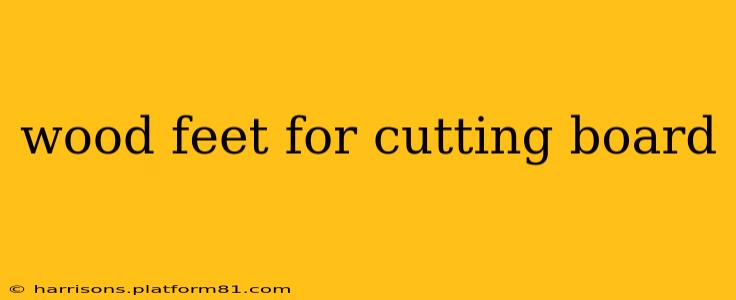Cutting boards are essential kitchen tools, but their stability can be compromised without proper support. Wood feet offer a simple yet effective solution, elevating your cutting board and providing several key advantages. This comprehensive guide explores the benefits of wood feet, addresses common questions, and helps you choose the perfect ones for your cutting board.
Why Use Wood Feet for Cutting Boards?
Wood feet offer a multitude of benefits that enhance both the functionality and lifespan of your cutting board. These include:
-
Increased Stability: The most obvious benefit is improved stability. Elevated cutting boards prevent wobbling and sliding, making chopping, slicing, and dicing safer and more efficient. This is especially crucial for larger cutting boards or those made from softer woods.
-
Protection of Work Surfaces: Raising the cutting board protects your countertops or tables from scratches and water damage. The wood feet act as buffers, preventing direct contact and preserving the integrity of your work surfaces.
-
Improved Hygiene: Elevating your cutting board allows for better air circulation underneath, which can help prevent the build-up of moisture and bacteria. This contributes to a cleaner and more hygienic work environment.
-
Enhanced Aesthetics: Wood feet can add a touch of elegance and sophistication to your cutting board, complementing its natural beauty. They can elevate the overall look of your kitchen workspace.
-
Extended Lifespan: By protecting both the cutting board and your counter, wood feet indirectly contribute to a longer lifespan for both.
What Types of Wood Feet Are Available?
Several types of wood feet cater to different preferences and cutting board styles:
-
Simple Button Feet: These are small, round or square feet that provide basic elevation and stability. They are readily available and easy to attach.
-
Tapered Feet: These feet have a wider base and taper upwards, offering increased stability and a more elegant look.
-
Cabinet Feet: These are larger and more substantial, providing superior stability for heavier cutting boards.
-
Adjustable Feet: These allow you to customize the height of your cutting board, accommodating uneven surfaces.
How Do I Attach Wood Feet to My Cutting Board?
Attaching wood feet is generally straightforward. The most common methods include:
-
Wood Glue: Apply a strong wood glue to the bottom of the feet and press them firmly onto the cutting board corners. Allow ample drying time according to the glue manufacturer's instructions.
-
Screws: For a more secure attachment, especially with heavier cutting boards, small screws can be used. Pre-drill pilot holes to prevent the wood from splitting.
-
Epoxy: Epoxy resin offers a very strong bond, ideal for outdoor cutting boards or those subjected to frequent moisture.
What Kind of Wood is Best for Cutting Board Feet?
The best wood for cutting board feet should be durable, moisture-resistant, and aesthetically pleasing. Hardwoods such as maple, oak, or cherry are excellent choices. These woods can withstand regular wear and tear, ensuring the feet remain sturdy and functional for a long time.
How Many Feet Do I Need?
The number of feet depends on the size and weight of your cutting board. For most cutting boards, four feet are sufficient, one at each corner. However, larger or heavier boards might benefit from additional support in the center.
Can I Make My Own Wood Feet for a Cutting Board?
Yes, you can! With basic woodworking skills and access to tools, crafting your own feet allows for customization in size, shape, and wood type. Online resources offer numerous tutorials and plans to guide you through the process.
Where Can I Buy Wood Feet for Cutting Boards?
Wood feet can be found at various retailers, including:
- Online marketplaces: Websites like Amazon and Etsy offer a wide selection of wood feet in different styles and materials.
- Woodworking supply stores: Local woodworking stores often carry a range of hardware, including wood feet.
- Hardware stores: Larger hardware stores may also stock basic wood feet.
By using wood feet, you can significantly improve the functionality, safety, and longevity of your cutting board. Choosing the right feet depends on your specific needs and preferences. With the right approach, you can transform your cutting board experience from wobbly to wonderfully stable!
